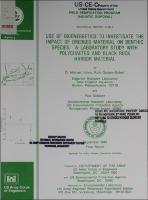Please use this identifier to cite or link to this item:
https://hdl.handle.net/11681/6437| Title: | Use of bioenergetics to investigate the impact of dredged material on benthic species : a laboratory study with polychaetes and Black Rock Harbor material |
| Authors: | Edgerton Research Laboratory. New England Aquarium Environmental Research Laboratory (Narragansett, R.I.) United States. Environmental Protection Agency Field Verification Program (Aquatic Disposal) Johns, D. Michael Gutjahr-Gobell, Ruth Schauer, Paul S. |
| Keywords: | Bioenergetics Techniques Procedures Dredging spoil Dredged material Marine pollution Aquatic pollution Water quality Polychaeta Benthos Benthic community Environmental effects Black Rock Harbor Bridgeport Connecticut |
| Publisher: | Environmental Laboratory (U.S.) Engineer Research and Development Center (U.S.) |
| Description: | Technical Report Abstract: Both solid phase and particulate phase assays were conducted with two species of polychaetes to determine the accuracy and reproducibility of conducting bioenergetic studies on polychaetes exposed to highly contaminated dredged sediment. The two species tested were Nephtys incisa, an errant burrowing sediment ingestor, and Neanthes arenaceodentata, a tube-building surface feeder. Exposure to various treatments was for 10 days. Results with both species of polychaetes indicate that, with few exceptions, all of the physiological parameters measured (rates of feeding, growth, reproduction, and ammonia excretion) can be made with accuracy. Changes in growth (determined as dry weight) between treatments, for example, can be measured following a 10-day exposure period providing that care is taken to adequately size the individual polychaete prior to initiation of the experiment. The bioenergetic endpoints measured in this study were found to be repeatable. In addition, physiological responses were found to be dose-dependent. Dosage was based on the relative proportion of reference and Black Rock Harbor sediment in a particular treatment. This investigation is the first phase in developing field verified bioassessment evaluations for the Corps of Engineers and EPA regulatory program for dredged material disposal. This report is not suitable for regulatory purposes; however, appropriate assessment protocols that are field verified will be available at the conclusion of this program. |
| Rights: | Approved for public release; distribution is unlimited. |
| URI: | http://hdl.handle.net/11681/6437 |
| Appears in Collections: | Technical Report |
Files in This Item:
| File | Description | Size | Format | |
|---|---|---|---|---|
| TR-D-85-7.pdf | 12.71 MB | Adobe PDF |  View/Open |